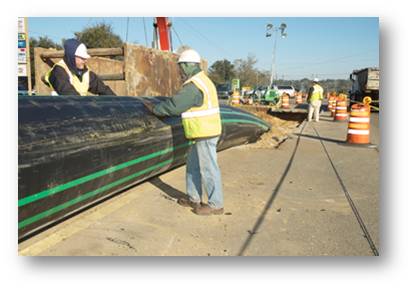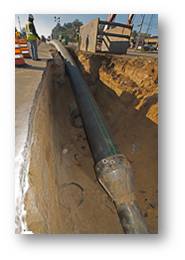
The Project
In August 2008, Tropical Storm Fay hit Tallahassee, causing widespread flooding and causing over 14-inches of rain to spill into sewage pump station basins. This massive storm created dramatic flow increases, pump failures and power fluctuations resulting in three main breaks in a two-mile section of the Force Main beneath the Capital Circle Roadway.
The Specifications
The city wanted a repair solution that would a) minimize traffic disruption to the heavily trafficked Tallahassee roadway, b) avoid pump upgrades at the existing upstream lift stations and c) maximize the hydraulic carrying capacity of the repaired section. Pipe bursting trenchless repair was the most logical choice; however bursting HOBAS piping had never been attempted before.

The Solution
To withstand the pipe bursting installation methods, Performance Pipe’s PE 4710 36-inch DIPS DR 13.5 was selected as the pipe material based on its increased density, high tensile strength, and high resistance to slow crack growth. A 280-foot pipe bursting pilot project was conducted to ensure the viability of the process. Upon successful completion of the pilot project, Performance Pipe provided an additional 7,400 linear feet of pipe to complete the repair.
The Benefits
This project demonstrated that large diameter HOBAS piping can be successfully replaced through pipe bursting construction methods. The benefits of utilizing pipe bursting repair methods when compared to traditional open cut installation included: reduced design time, reduced construction time, minimal disruption to traffic and local businesses, minimal excavation and restoration of the existing roadway, and reduced construction costs. By utilizing Performance Pipe’s 36-inch DIPS 13.5 PE 4710 pipe and the pipe bursting method, the city realized a $250,000 cost savings for the two mile project.